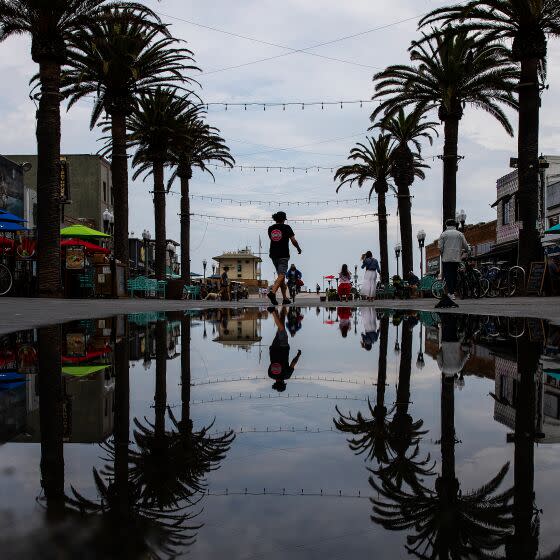Seeing flood warnings? Here's how to check your flood risk

As if a historic heat wave wasn't enough to think about, Southern Californians now have flood warnings at the top of their minds.
Tropical Storm Kay, a system along the northern coast of Mexico's Baja California peninsula, is expected to cause heavy rains, flash flooding, strong winds and muggy conditions through Saturday.
However, for most of Southern California this storm is going to be a boon, not a bane, said Daniel Swain, a climate scientist at UCLA's Institute of the Environment and Sustainability.
It "will cause more reduction in fire risk than it will cause harm through other things like flooding, for the most part," Swain said.
There are some exceptions, he said. For example, eastern San Diego and Imperial counties — the southeastern deserts — have the potential for widespread and severe flash flooding. And gusty winds could complicate firefighting efforts, while particularly intense downpours in a wildfire footprint could produce severe debris flows.
Heavy rains will probably stay down in San Diego and Imperial counties, however, sparing the recent burn areas farther north, Swain said. He added that the place most likely to benefit from the storm is the coastal plain, where the rain "will finally cool everybody down."
So should you brace for authorities to declare a flood warning? In a word, yes. We might not experience one this weekend, but it doesn't hurt to prepare for the future.
According to the California Department of Water Resources, the state experiences many types of flooding, including alluvial fan, riverine, coastal, flash, and localized floods, as well as debris flows and tsunamis.
As their name suggests, flash floods can develop quickly, sometimes in just a few minutes and without visible signs of rain, according to Ready L.A. County.
Be aware of flood hazards wherever you live, but especially if your home is in a low-lying area, near water or near a recently burned hillside, Ready L.A. County advises.
Check the flood risk in your area
Use a flood map to understand the flood risk in your community and whether your home is in a flood zone.
A flood zone means the area has a potential for flooding during heavy rains or a weather disaster.
Two government agencies — the Federal Emergency Management Agency and the California Governor's Office of Emergency Services — provide information online about flood risks and other hazards across California. All you have to do is plug your address into the search tool to see what issues your home faces.
On the FEMA map, moderate- to low-risk flood areas are labeled with the letters B, C and X. In these areas the risk of being flooded is reduced but not eliminated. High-risk flood areas are labeled with the letters A and V.
A community's flood risk changes over time, so the National Food Insurance Program and the Federal Emergency Management Agency continuously work with communities across the country to identify and map flood risks.
Prepare for flooding
Preparing for a flood — or any kind of emergency situation, for that matter — starts with you making a plan with your immediate family and neighbors.
Part of that plan includes packing a go-bag that should have important documents (in a Ziplock or another type of waterproof bag), medication, an extra set of glasses (or contacts), a comfortable pair of shoes, a change of clothes, small bills (a number of $1 and $5 bills), a phone charger, flashlight, water and nonperishable food.
If you have pets, pack food, treats and an extra leash if you have one.
Keep in mind every family member's needs when creating your go-bag.
Emily Montanez, associate director for L.A. County's Office of Emergency Management, said you should try to create a small community of close neighbors to check in with when disaster strikes. Consider creating an emergency contact list on paper in the event your phone stops working or the battery dies and you can't check the contacts there, she said.
Follow Emergency orders
If an evacuation is ordered or advised in your community, evacuate immediately.
Montanez said when it comes to safety, listen to first responders.
"If anyone receives a knock at their front door from someone in law enforcement or [from] the fire department, we definitely support taking the safest approach and evacuate your home," she said.
Stay in the know about warnings and alerts by signing up with your local emergency mass notification system.
Los Angeles County residents can sign up with Alert L.A. County, Notify L.A. and Nixle to receive notifications via text message or email. Stay updated on weather forecasts by tuning in to your local news broadcast station and checking the National Weather Service Los Angeles office website.
If a flood warning or watch is issued for your community and you have some time before evacuating, relocate valuables (particularly water-sensitive ones, such as laptops, tablets and smart kitchen devices) from lower to upper floors. You should also disconnect all electrical appliances or turn off electric circuits at the fuse box or circuit breaker panel.
If you have been evacuated, wait until authorities give the all-clear to return to your home.
This story originally appeared in Los Angeles Times.